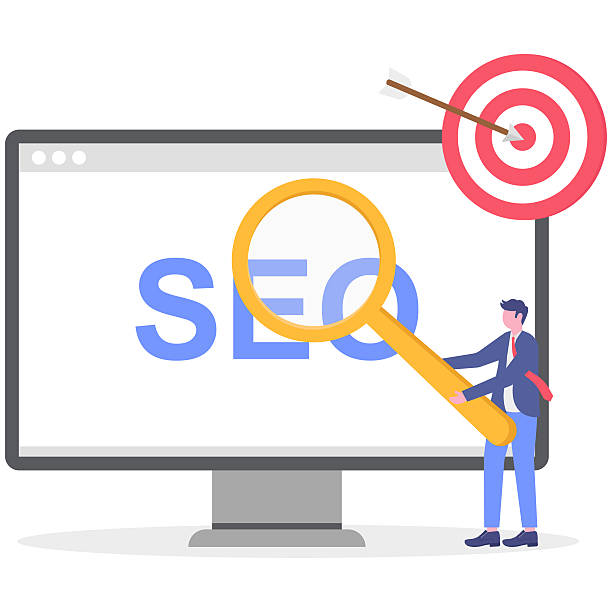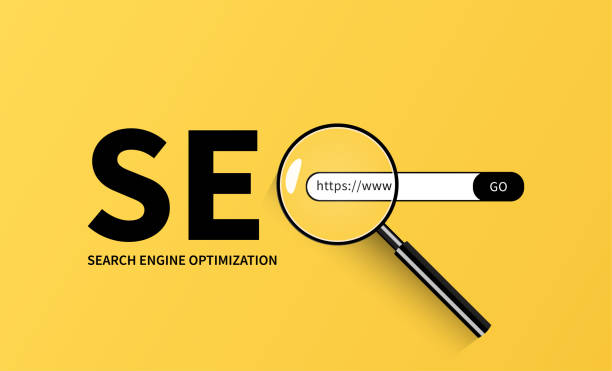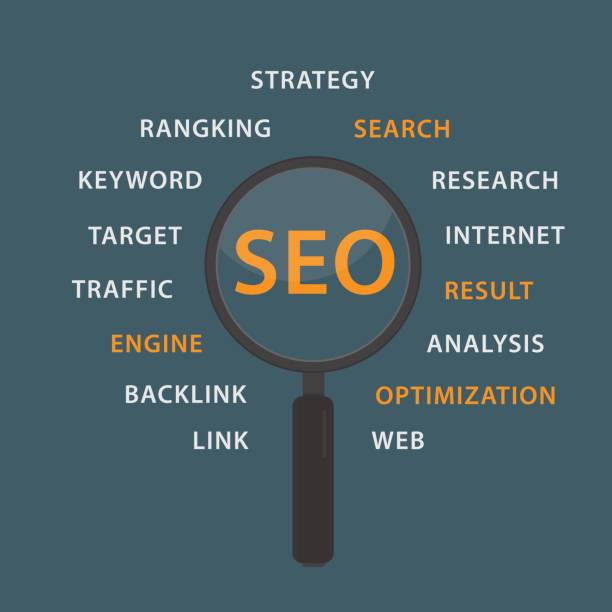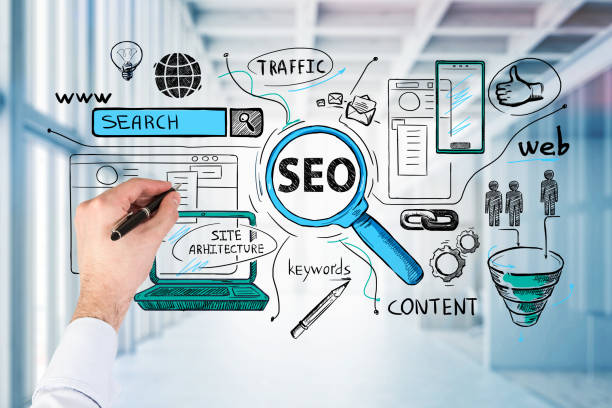Introduction to On-Page SEO and Its Critical Importance

In today’s highly competitive digital world, visibility among the vast number of websites and content is no longer an option, but an undeniable necessity.
Meanwhile, On-Page SEO or On-Page Optimization (On-Page SEO) is recognized as the backbone of every successful digital marketing strategy.
This part of search engine optimization refers to all actions taken directly within your website and on its pages to improve its ranking in search results.
Unlike Off-Page SEO, which deals with external factors like backlinks, #on_page_seo_focuses primarily on the quality and structure of your content, HTML markups, and user experience.
The main goal of this area of SEO is to help search engines better understand the topic and value of your pages, so they can display them to the target audience.
Imagine your website is a large library; without proper #on_page_seo, your books (web pages) might be misplaced, have unclear titles, or have unreadable tables of contents.
As a result, visitors (Google bots) cannot easily find what they are looking for, and the value of your content is overlooked.
The importance of this type of optimization is that you have complete control over it; any change you make to your website, whether in HTML codes, content text, or link structure, directly affects your #on_page_seo_performance.
Understanding and correctly implementing these principles not only helps improve your ranking but also enhances user experience and ultimately leads to increased conversion rates and longer user retention on your site.
This introduction is just the tip of the iceberg, and we will delve into the details of these vital factors further on.
This is an educational and fundamental topic for anyone who wants to succeed in the online world.
Is your online sales not as expected? With Rasawweb, solve the problem of low sales and poor user experience forever!
✅ Increase visitor-to-customer conversion rate
✅ Create a pleasant user experience and increase customer trust
⚡ Act now to receive a free consultation!
Keyword Research, the Cornerstone of On-Page SEO

Keyword research (keyword research) is not just an initial step, but a vital and continuous process in On-Page SEO strategy.
Choosing the right keywords helps search engines correctly categorize your content and display it to users who are looking for relevant information.
Without this step, even the highest quality content might never be discovered by its audience.
In fact, this is where the specialized topic of SEO comes into play.
To conduct effective keyword research, you need to put yourself in the audience’s shoes.
What words or phrases do they use to search for your services or products? What questions do they have that your content can answer?
Various tools such as Google Keyword Planner, Semrush, Ahrefs, and even Google’s suggestion features (Google Autocomplete) can help you in this process.
But simply finding high-volume keywords is not enough; you must also pay attention to “Search Intent”.
Is the user looking for information (Informational Intent)? Do they intend to buy (Transactional Intent)? Are they looking for a specific website (Navigational Intent)? Or are they researching before a purchase (Commercial Investigation Intent)? Matching your content with the user’s search intent is one of the strongest signals for search engines and an integral part of On-Page SEO.
Long-tail keywords are also of high importance.
These phrases, usually consisting of three or more words, are less competitive and have a more specific search intent.
For example, instead of “SEO,” “How to improve website on-page SEO?” is a long-tail keyword that more precisely indicates the user’s intent and has a higher conversion probability.
After selecting suitable keywords, the next step is guidance towards their natural and strategic use in the title, body text, and page meta tags, which we will discuss in subsequent sections.
Do not forget that on-page optimization without a strong foundation of keywords is like building a house without a foundation.
Content and Title Optimization in On-Page SEO

Content is king, and this statement especially holds true in the context of On-Page SEO.
After identifying suitable keywords, it’s time to create content that is both engaging and useful for users, and understandable for search engines.
The page title (Title Tag) is the first thing a user sees in search results and significantly impacts the click-through rate (CTR).
The title should contain the main keyword, be appealing, and preferably be between 50 to 60 characters.
The Meta Description, although not directly affecting ranking, entices users to click by providing an appealing summary of the content.
The optimal length for a meta description is about 150 to 160 characters and it should include keywords.
Content quality goes beyond simply placing keywords.
Your content should be explanatory, comprehensive, and responsive to user needs.
Using logical headings (H1, H2, H3, etc.) helps with content readability and structuring.
On-Page Optimization also includes the use of related keywords (LSI keywords); words that are semantically close to your main keyword and help search engines better understand the page’s topic.
This is an educational strategy to help Google understand the context of your content.
For example, if your keyword is “healthy nutrition,” related words could include “balanced diet,” “vitamins,” “minerals,” “weight loss,” and “general health.”
This prevents keyword stuffing and makes your content appear more natural and useful.
| On-Page SEO Element | Importance | Description and Tips |
|---|---|---|
| Title Tag | Very High | First user interaction with your page in search results. Should include the main keyword and be engaging (50-60 characters). |
| Meta Description | Medium | An engaging summary to encourage clicks. Includes keywords and a call-to-action (150-160 characters). |
| Headings (H1-H6) | High | Structuring content and improving readability. H1 once per page and includes the main keyword. |
| Keyword Density | Medium | Natural use of keywords (0.5% – 2%); avoid Keyword Stuffing. |
| Content Quality | Crucial | Should be comprehensive, useful, accurate, and unique. Addresses user needs. |
Content and SEO teams must collaborate to ensure that the produced content is not only valuable but also properly optimized for On-Page SEO.
Analytical content that provides new data or news content that addresses current events can attract significant traffic, provided they are properly optimized for search engines.
The Role of Image and Video Optimization in On-Page SEO

In the current era, visual content such as images and videos plays a prominent role in attracting user attention and improving user experience.
However, their importance is not limited to visual appeal; these elements can significantly impact your website’s On-Page SEO, provided they are properly optimized.
The first and perhaps most important step in image optimization is the use of the Alt Text (alternative text) tag.
This tag provides a brief description of the image content, which is understandable for both search engines and users who cannot view the image for various reasons (such as slow internet speed or visual impairment).
Alt Text should be descriptive, relevant to the content, and contain keywords (naturally, not with stuffing).
Image file naming is also of high importance.
Instead of generic names like “IMG001.jpg,” use descriptive names like “on-page-seo-optimization.jpg”.
This simple guidance helps search engines better understand the image’s topic.
Furthermore, image compression without significant loss of quality is crucial for improving page loading speed (Page Speed).
Pages with high loading speeds not only offer a better user experience but also have an advantage in Google’s rankings.
Using appropriate image formats like WebP can also help reduce file size.
This aspect of On-Page SEO can significantly impact your site’s performance.
For videos, optimization includes more aspects.
Video titles and descriptions should be accurate, comprehensive, and include keywords.
Using transcripts or subtitles for videos helps search engines index audio content and increases accessibility for users.
Schema Markup for videos can also provide more information to search engines and lead to richer displays (rich snippets) in search results.
This specialized approach ensures your videos appear in Google’s video results or even in specific sections of regular search results.
In general, attention to detail in optimizing visual elements is an important and often overlooked aspect of on-page optimization that can yield significant results.
Tired of your e-commerce website not generating as much revenue as it could? Rasawweb, specializing in professional e-commerce website design, solves this problem forever!
✅ Increase sales rate and revenue
✅ High loading speed and unparalleled user experience
⚡ Get a free e-commerce website design consultation
Internal Linking and Its Importance for On-Page SEO

Internal linking or Internal Linking is one of the most powerful tools available to On-Page SEO specialists.
This process means creating links from one page on your website to another page on the same website.
This is crucial for SEO and user experience for several fundamental reasons.
Firstly, internal links help search engines better understand your website’s structure and discover and index different pages.
The more internal links a page receives from relevant and high-authority pages, the more valuable it becomes to search engines, which can help improve that page’s ranking.
This is a key guidance for distributing internal site authority.
Secondly, internal links help transfer “PageRank” or link authority throughout your website.
Pages with high authority (e.g., pages that have received many backlinks from external sites) can transfer this authority to other pages through internal links, helping to improve their rankings.
This is a specialized concept for distributing SEO power within your site.
Thirdly, internal linking improves user experience (UX).
It enables users to easily navigate your website and discover more relevant information.
This increases user dwell time on the site and reduces bounce rate, both of which are positive signals for search engines.
For effective on-page optimization through linking, several key points should be considered:
- Anchor Text: Use descriptive anchor texts containing relevant keywords.
Instead of “Click here,” use phrases like “complete guide to on-page SEO.” - Topical Relevance: Internal links should always be created between thematically related pages.
Linking from an article about cooking to an article about software has no SEO benefit and can even be detrimental. - Number of Links: Although there’s no strict rule for the number of links, avoid excessive and unnatural links that might appear spammy.
Links should look natural and logical. - Link to Deeper Pages: Use your homepage and high-authority pages to link to newer pages or those that need strengthening.
With a smart internal linking strategy, you can optimize the flow of SEO authority within your website and ultimately help improve the ranking of all pages in search results.
This part of On-Page SEO is a long-term investment that yields high returns.
Technical On-Page SEO Aspects

The technical aspects of On-Page SEO, though less visible, form the backbone of a website with strong SEO performance.
These elements ensure that search engines can easily crawl and index your website.
The first and one of the most important is URL structure.
URLs should be short, descriptive, and contain the page’s main keywords.
Using hyphens (-) to separate words instead of underscores (_) or spaces is recommended.
Also, avoid URLs containing numbers and unclear characters, as this guidance helps search engines better understand the page’s topic.
Site loading speed (Site Speed) is an important ranking factor.
Google’s Core Web Vitals metrics (LCP, FID, CLS) are measured based on actual user experience and have a direct impact on On-Page SEO.
Image optimization, code compression (CSS, JavaScript), caching, and choosing suitable hosting all contribute to improving site speed.
Today, websites must be responsive and mobile-friendly.
Google has adopted “Mobile-first” indexing, meaning the mobile version of your site is used for ranking.
This is an explanatory and crucial section for any website.
Schema Markup or structured data are codes added to your website to help search engines better understand your content and display it in a richer format (Rich Snippets) in search results.
This can include information about products, events, articles, user reviews, and more.
Using Schema Markup can take on-page optimization to a new level and significantly increase your click-through rate.
Furthermore, the correct use of Canonical Tags to prevent duplicate content, the robots.txt file to control search engine crawling, and the role of XML Sitemap to help search engines discover all website pages, are all integral parts of a strong On-Page SEO strategy.
Ignoring these technical aspects can render even the best content ineffective.
This is a specialized topic that requires technical expertise.
User Experience (UX) and Its Impact on On-Page SEO

In the past, On-Page SEO primarily focused on technical factors and keywords.
However, over time and with the increasing intelligence of search engine algorithms, User Experience (UX) has become one of the most significant factors influencing ranking.
Google and other search engines strive to provide the best results to their users, which means displaying websites that not only have relevant content but also offer a pleasant and easy experience for visitors.
Have you ever considered how a poor design and difficult navigation can render all your efforts in internal site optimization ineffective? This is a thought-provoking content point that many web designers overlook.
UX factors such as Bounce Rate, Time on Page, Scroll Depth, and Click-Through Rate (CTR) all send indirect yet powerful signals to search engines.
If users quickly leave your site (high bounce rate) or spend little time on it, this indicates that your content or design does not meet their needs.
In contrast, good UX encourages users to spend more time on the site, visit more pages, and interact with your content.
This user behavior indicates that your website is valuable and can lead to improved rankings in search results.
To improve UX and strengthen On-Page SEO, pay attention to the following:
- Responsive Design: Ensure your website displays correctly on all devices (mobile, tablet, desktop).
- Page Loading Speed: As previously mentioned, high speed is crucial for UX.
- Easy Navigation: Menus should be clear, logical, and accessible.
Users should easily find what they are looking for. - Content Readability: Using short paragraphs, headings, lists, and appropriate font helps with content readability.
- Clear Call-to-Action (CTA): Guide users to take the next step (e.g., purchase, sign up, read more).
A user-friendly website not only attracts more traffic but also signals to search engines that you value the visitor experience.
This analytical approach to SEO puts you on the right path for On-Page SEO success.
| UX Factor | Impact on On-Page SEO | How to Improve? |
|---|---|---|
| Page Loading Speed | Direct and crucial; improves ranking and reduces bounce rate. | Image compression, using CDN, code optimization. |
| Responsive Design (Mobile-Friendly) | Essential; Google uses Mobile-first indexing. | Designing a responsive website that displays well on all devices. |
| Website Navigation | High; improves search engine crawling and reduces bounce rate. | Clear menus, logical hierarchical structure, effective internal linking. |
| Content Readability | High; increases time on page and user engagement. | Using headings, short paragraphs, lists, appropriate font size. |
| Call-to-Action (CTA) | Medium; increases conversion rate and engagement signal. | Clear and engaging CTAs, strategic placement. |
Tools and Resources for Improving On-Page SEO

To succeed in On-Page SEO optimization, knowledge alone is not enough; you need appropriate tools to analyze, monitor, and improve your website’s performance.
These tools provide valuable data that helps you identify the strengths and weaknesses of your On-Page SEO strategy.
One of the most vital free and essential tools is Google Search Console (GSC).
GSC allows you to monitor your site’s performance in search results, identify crawling and indexing issues, view Core Web Vitals errors, and even submit your URLs to Google for review.
This is an excellent educational resource for understanding how Google interacts with your site.
Alongside GSC, there are also paid and more advanced tools that offer deeper analytical capabilities for On-Page SEO.
SEMrush, Ahrefs, and Moz are among the most popular of these tools.
These platforms allow you to:
- Keyword Research: Find new keywords, analyze competition, and discover opportunities.
- Competitor Analysis: View your competitors’ keywords, content strategies, and link-building.
- Technical Site SEO: Identify technical errors such as broken links, duplicate or missing meta tags.
- Content Optimization Suggestions: Provide suggestions for improving existing content based on keywords and competition.
To become specialized in SEO, using these tools is essential.
Content optimization tools like Yoast SEO or Rank Math for WordPress also help you easily monitor and optimize On-Page SEO factors on each page.
These plugins provide checklists for titles, meta descriptions, keyword density, text readability, and internal linking.
Additionally, tools like Google PageSpeed Insights and Google Mobile-Friendly Test are very useful for checking your site’s speed and mobile-friendliness.
Properly utilizing these tools and resources enables you to continuously evaluate and improve your On-Page SEO strategy and ultimately achieve better results.
This is a comprehensive guide for anyone who wants to pursue on-page optimization professionally.
Frustrated by your e-commerce site’s low conversion rate? Rasawweb transforms your e-commerce site into a powerful tool for attracting and converting customers!
✅ Significant increase in visitor-to-buyer conversion rate
✅ Unparalleled user experience to boost customer satisfaction and loyalty⚡ Get a free consultation from Rasawweb!
New Trends and the Future of On-Page SEO

The world of SEO is never static, and On-Page SEO is no exception.
Google’s algorithms are constantly evolving, and keeping up with the latest trends is crucial for maintaining competitiveness.
One of the most significant recent developments is the increasing focus on E-A-T (Expertise, Authoritativeness, Trustworthiness).
Google aims to show high-quality and authoritative content from reliable sources to its users, especially in sensitive areas like health and finance (Your Money or Your Life – YMYL).
This means that for on-page optimization, you must ensure your content is produced by experts, links to reputable sources, and is itself a trustworthy source for users.
This is an important news for content creators.
Voice Search is also growing exponentially.
With the increasing use of voice assistants like Google Assistant and Siri, optimizing for voice search has become a necessity.
This means focusing on longer keywords, conversational content, and direct answers to questions, as users typically ask full questions in voice search.
This is an analytical trend that shows how changes in user behavior also change SEO.
Artificial Intelligence (AI) is also changing the landscape of On-Page SEO.
Google algorithms like BERT and MUM use AI to better understand the meaning of content and user search intent.
This means that merely placing keywords is not enough; content must be semantically rich and fully answer user questions.
Also, AI content generation tools are emerging, but they still cannot replace high-quality, human-created content.
Page Experience, of which Core Web Vitals is an important part, remains a focal point for Google.
This includes loading speed, interactivity, and visual stability of the page.
Websites should continuously monitor and improve these metrics.
Finally, rewarding and creative content that goes beyond mere information has also gained importance.
This can include infographics, interactive videos, quizzes, and more,
which further engage users and increase their time on site.
Understanding these trends and adapting your On-Page SEO strategy to them is key to future success.
Conclusion and On-Page SEO Checklist

As thoroughly explained in this educational and comprehensive article, On-Page SEO is considered the main pillar of any successful search engine optimization strategy.
From precise keyword research and content optimization to website technical aspects and focusing on user experience, each component plays a vital role in your website’s visibility and ranking in Google results.
Ignoring any of these elements can render your efforts fruitless.
On-page optimization is not a one-time process but requires continuous monitoring, data analysis, and adaptation to the latest changes in search engine algorithms.
This is a long-term investment whose returns manifest as increased organic traffic, improved brand credibility, and ultimately, increased sales and revenue.
To have all the points mentioned in this article available in one place and actionable, we have provided a checklist of the most important On-Page SEO actions below.
This checklist is a comprehensive guide for anyone looking to improve their site’s performance:
- Comprehensive Keyword Research: Identify main and long-tail keywords relevant to your content and pay attention to search intent.
- Title Tag Optimization: The title should be engaging, contain main keywords, and be between 50-60 characters.
- Meta Description Optimization: An appealing summary (150-160 characters) with keywords and a call-to-action.
- Use of Headings (H1-H6): Logical structuring of content for better readability and inclusion of keywords.
- Content Quality and Depth: Produce comprehensive, unique, valuable content that meets user needs.
- Image and Video Optimization: Use descriptive Alt Text, appropriate file naming, compression, and Schema Markup for videos.
- Effective Internal Linking: Link to relevant pages with descriptive anchor texts for authority distribution and improved navigation.
- URL Optimization: Short, descriptive URLs containing keywords.
- Site Loading Speed: Improve Core Web Vitals and optimize page speed.
- Mobile-Friendliness: Ensure the website design is responsive.
- Use of Schema Markup: To increase content comprehensibility for search engines and display Rich Snippets.
- User Experience (UX) Improvement: Easy navigation, content readability, appealing design, and clear calls-to-action.
By implementing this checklist and continuously reviewing your data, you not only improve your site’s ranking in search results but also provide an unparalleled user experience for your visitors.
This path might be long, but its results will certainly be rewarding and satisfying.
So start today and optimize your website!
Frequently Asked Questions
| No. | Question | Answer |
|---|---|---|
| 1 | What is On-Page SEO? | On-Page SEO refers to a set of actions performed within the website (on its pages) to improve its ranking in search engine results. This includes content optimization, site structure, and HTML codes. |
| 2 | Why is On-Page SEO important? | On-Page SEO helps search engines better understand page content and determine if that page is relevant and valuable for user searches. This better understanding leads to higher rankings. |
| 3 | What is the first and most important step in On-Page SEO? | Keyword Research is the most important initial step. By finding suitable keywords, targeted content relevant to user needs can be produced. |
| 4 | What is the role of the Title Tag in On-Page SEO? | The title tag is one of the most important ranking factors and should include the main keyword. This tag is displayed as the page title in search results and affects the click-through rate (CTR). |
| 5 | What is the importance of Meta Description? | The meta description does not directly impact ranking, but by providing an appealing summary of the page content in search results, it can encourage users to click, thereby increasing the click-through rate (CTR). |
| 6 | Why is using headings (H1, H2, etc.) in content important? | Headings help structure content and improve readability for users and search engine crawlers. Using keywords in headings also helps search engines better understand the topic. |
| 7 | What does Image Optimization in On-Page SEO include? | It includes compressing images to reduce size, using descriptive and relevant file names, and filling the Alt tag (alternative text) with relevant keywords to help search engines understand the image content. |
| 8 | What is Internal Linking in On-Page SEO? | Internal linking refers to creating links between different pages of a website. This helps in distributing page authority (Link Equity), improving user experience, and assisting search engine crawlers in discovering new pages. |
| 9 | Why is Page Speed important for On-Page SEO? | Page loading speed is a direct ranking factor and significantly impacts user experience. Slow pages can lead to an increased bounce rate and reduced user engagement. |
| 10 | What role does quality content play in On-Page SEO? | High-quality, comprehensive, unique, and valuable content for the user is the core of On-Page SEO. This content not only attracts and retains users but also sends positive signals to search engines, helping with better rankings. |
And other advertising services of Rasawweb Advertising Agency
Smart Digital Advertising: An effective tool for digital branding with the help of user experience customization.
Smart Website Development: A professional solution to increase click-through rates by focusing on intelligent data analysis.
Smart Digital Branding: Professional optimization to increase click-through rates using user experience customization.
Smart Data Analysis: A professional solution to improve SEO ranking by focusing on intelligent data analysis.
Smart Website Development: A professional solution for customer acquisition by focusing on the use of real data.
And over hundreds of other services in the field of internet advertising, advertising consultation, and organizational solutions
Internet Advertising | Advertising Strategy | Advertorial
Resources
Seokar Blog
Mihanweb Host Blog
Webram Blog
Toplearn Blog (SEO)
? With Rasawweb Afarin Digital Marketing Agency, lead your business on the path to digital success. From custom website design to SEO optimization and advertising campaign management, we are with you every step of the way to ensure a powerful and impactful online presence. Contact us for consultation and to start your business’s digital transformation.
📍 Tehran, Mirdamad Street, next to Bank Markazi, Southern Kazeroun Alley, Ramin Alley, No. 6

